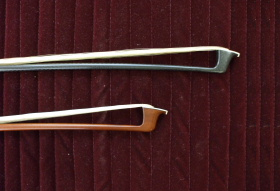Choosing a Violin
Choosing a bow
The best material is pernambuco wood

Carbon bow (top) and wooden bow (bottom)
The best wood for making bows is the extremely hard wood of the pernambuco tree. This wood can be shaped into the delicate shape of a bow because it is so hard and strong.
The shape, weight, balance, and other features of the bow differ between makers. The only way to select one is to try them all personally. A newly made instrument can be played energetically with a new bow, but an old instrument should probably be played with an old bow to bring out the unique characteristics of the instrument.
Carbon bows have become popular recently. Once you become proficient, it is convenient to have one as a spare when the other bow is being rehaired or is otherwise unavailable. Some modern music also calls for tapping the instrument with the bow, which might not be an attractive proposition with an expensive wooden bow. Some people keep a carbon bow handy for these situations.
The carbon bow produces a much louder and clearer sound than a wooden bow, and so it may be useful for certain pieces. Care, maintenance, and adjustment are the same as with traditional bows.
Musical Instrument Guide : Violin Contents
Origins
Structure
How to Play
How the Instrument is Made
Choosing an Instrument
Care and Maintenance
Trivia
- The f-hole used to be a C-hole or S-hole
- Why the f-hole?
- Violinists must bow to the horse
- Steel strings or gut strings? That is the question
- Is the chinrest the unsung hero of the violin?
- Most violin varnishes are also medicines
- Violin masterpieces: Solos I
- Violin masterpieces: Solos II
- Violin masterpieces: Solos III
- Violin masterpieces: Concertos I
- Violin masterpieces: Concertos II
- Viola masterpieces: Chamber music
- Viola masterpieces: Concertos
- Cello masterpieces: Concertos I
- Cello masterpieces: Concertos II
- Cello masterpieces: Solos
- Contrabass masterpieces: Concertos
- Contrabass masterpieces: Chamber music
- Orchestral masterpieces featuring the contrabass
- What do you call the part on the bow that you hold?
